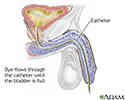Voiding cystourethrogram
Cystourethrogram - voiding
A voiding cystourethrogram is an x-ray study of the bladder and urethra. It is done while the bladder is emptying.
How the Test is Performed
The test is performed in a hospital radiology department or in a health care provider's office.
You will lie on your back on the x-ray table. A thin, flexible tube called a catheter will be inserted into the urethra (the tube that carries urine from the bladder to the outside of the body) and passed into the bladder.
Contrast dye flows through the catheter into the bladder. This dye helps the bladder show up better on x-ray images.
The x-rays are taken from various angles while the bladder is full of contrast dye. The catheter is removed so that you can urinate. Images are taken while you empty your bladder.
How to Prepare for the Test
You must sign a consent form. You will be given a gown to wear.
Remove all jewelry before the test. Inform the provider if you are:
- Allergic to any medicines
- Allergic to x-ray contrast material
- Pregnant
How the Test will Feel
You may feel some discomfort when the catheter is placed and while your bladder is full.
Why the Test is Performed
This test may be done to diagnose the cause of urinary tract infections, especially in children who have had more than one urinary tract or bladder infection.
It is also used to diagnose and evaluate:
- Difficulty emptying the bladder
- Birth defects with the bladder or urethra
- Narrowing of the tube that carries urine out of the bladder (urethral stricture) in males
- Urinary reflux from the bladder up into the kidney
Normal Results
The bladder and urethra will be normal in size and function.
What Abnormal Results Mean
Abnormal results may indicate the following:
- Bladder does not empty properly because of a brain or nerve problem (neurogenic bladder)
- Enlarged prostate gland
- Narrowing or scarring of the urethra
- Pouch-like sacs (diverticula) on the walls of the bladder or urethra
- Ureterocele
- Urinary reflux nephropathy
Risks
You may have some discomfort when urinating after this test because of irritation from the catheter.
You may have bladder spasms after this test, which may be a sign of an allergic reaction to the contrast dye. Contact your provider if bothersome bladder spasms occur.
You may see blood in your urine for a couple of days after this test.
References
Bellah RD, Tao TY. Pediatric genitourinary radiology. In: Torigian DA, Ramchandani P, eds. Radiology Secrets Plus. 4th ed. Philadelphia, PA: Elsevier; 2017:chap 88.
Elder JS. Vesicoureteral reflux. In: Kliegman RM, St. Geme JW, Blum NJ, Shah SS, Tasker RC, Wilson KM, eds. Nelson Textbook of Pediatrics. 21st ed. Philadelphia, PA: Elsevier; 2020:chap 554.
Stanasel I, Peters CA. Ectopic ureter, ureterocele, and ureteral anomalies. In: Partin AW, Dmochowski RR, Kavoussi LR, Peters CA, eds. Campbell-Walsh-Wein Urology. 12th ed. Philadelphia, PA: Elsevier; 2021:chap 41.
Review Date: 1/1/2023
Reviewed By: Kelly L. Stratton, MD, FACS, Associate Professor, Department of Urology, University of Oklahoma Health Sciences Center, Oklahoma City, OK. Also reviewed by David C. Dugdale, MD, Medical Director, Brenda Conaway, Editorial Director, and the A.D.A.M. Editorial team.








